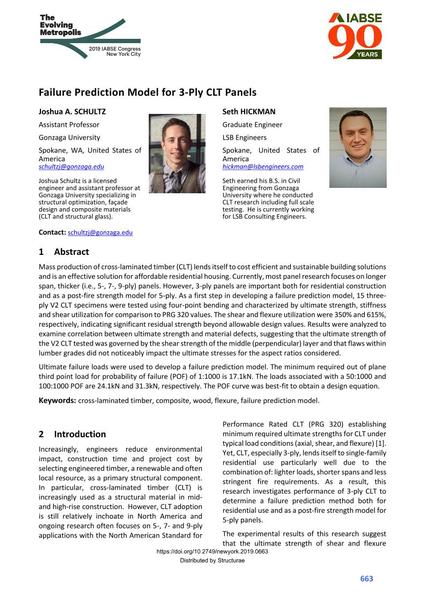Failure Prediction Model for 3-Ply CLT Panels

|
|
|||||||||||
Détails bibliographiques
| Auteur(s): |
Joshua A. Schultz
(Gonzaga University)
Seth Hickman (LSB Engineers) |
||||
|---|---|---|---|---|---|
| Médium: | papier de conférence | ||||
| Langue(s): | anglais | ||||
| Conférence: | IABSE Congress: The Evolving Metropolis, New York, NY, USA, 4-6 September 2019 | ||||
| Publié dans: | The Evolving Metropolis | ||||
|
|||||
| Page(s): | 663-667 | ||||
| Nombre total de pages (du PDF): | 5 | ||||
| DOI: | 10.2749/newyork.2019.0663 | ||||
| Abstrait: |
Mass production of cross-laminated timber (CLT) lends itself to cost efficient and sustainable building solutions and is an effective solution for affordable residential housing. Currently, most panel research focuses on longer span, thicker (i.e., 5-, 7-, 9-ply) panels. However, 3-ply panels are important both for residential construction and as a post-fire strength model for 5-ply. As a first step in developing a failure prediction model, 15 three-ply V2 CLT specimens were tested using four-point bending and characterized by ultimate strength, stiffness and shear utilization for comparison to PRG 320 values. The shear and flexure utilization were 350% and 615%, respectively, indicating significant residual strength beyond allowable design values. Results were analyzed to examine correlation between ultimate strength and material defects, suggesting that the ultimate strength of the V2 CLT tested was governed by the shear strength of the middle (perpendicular) layer and that flaws within lumber grades did not noticeably impact the ultimate stresses for the aspect ratios considered. Ultimate failure loads were used to develop a failure prediction model. The minimum required out of plane third point load for probability of failure (POF) of 1:1000 is 17.1kN. The loads associated with a 50:1000 and 100:1000 POF are 24.1kN and 31.3kN, respectively. The POF curve was best-fit to obtain a design equation. |
||||
| Mots-clé: |
bois
|
||||
